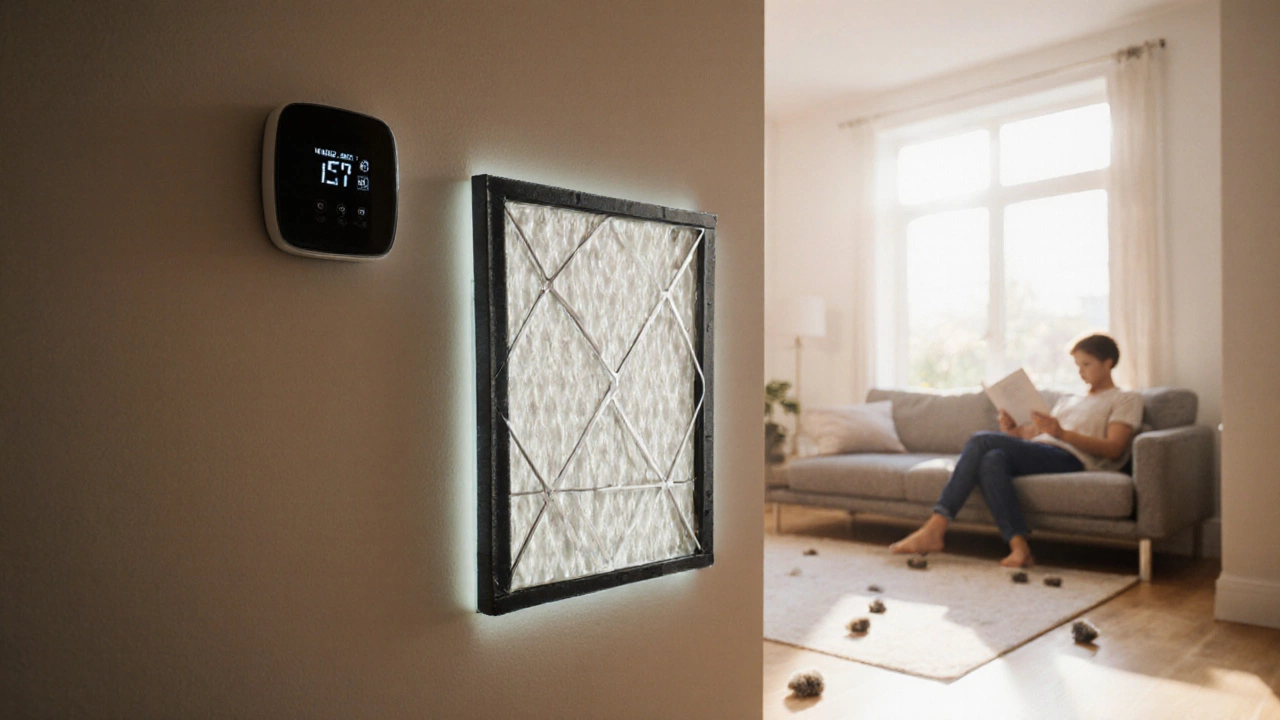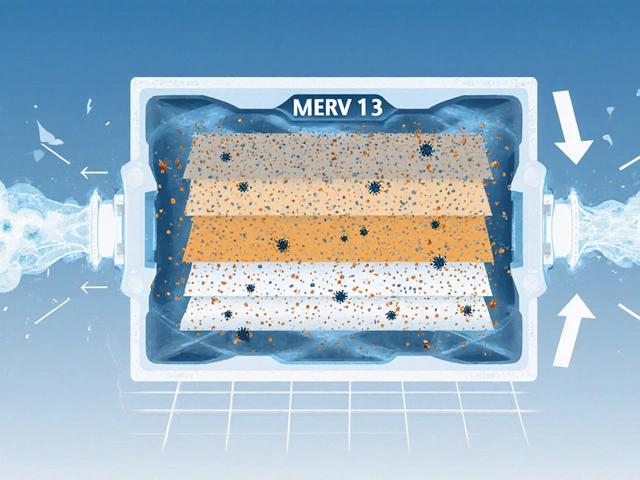MERV Rating Compatibility Checker
Enter your details and click "Check MERV 13 Compatibility" to get personalized recommendations.
MERV 13 Filter Benefits
- Catches 75% of particles at 0.3 µm
- Reduces allergens, pollen, mold spores
- Helps protect HVAC coils
- Good for allergy-sensitive households
Potential Drawbacks
- Higher pressure drop
- More frequent replacements needed
- Increased cost per filter
- May strain older systems
When you hear the term MERV 13 you might picture a hospital‑grade filter and wonder if it belongs in a regular house. The truth is a bit more nuanced - the rating isn’t automatically too high, but it does interact with your HVAC system, budget, and health needs. Below we break down what the rating means, when it makes sense for a residential setup, and what trade‑offs to expect.
What Does a MERV Rating Actually Measure?
MERV rating is a scale created by the American Society of Heating, Refrigerating and Air‑Conditioning Engineers (ASHRAE) that grades air filters by how efficiently they capture particles of varying sizes. The scale runs from 1 (coarse debris) to 20 (near‑HEPA performance). A higher number means finer particles are trapped, but it also usually means more resistance to airflow.
How MERV 13 Stacks Up Against Common Home Filters
| Rating | Particle Size Captured (µm) | Efficiency at 0.3µm | Typical Pressure Drop (in.w.g.) | Best‑Fit Home Type | Cost per Filter (USD) |
|---|---|---|---|---|---|
| MERV 8 | 3‑10 | ~20% | 0.10‑0.15 | Basic HVAC, low‑budget | 1‑3 |
| MERV 11 | 1‑3 | ~40% | 0.15‑0.25 | Average family, pets | 3‑5 |
| MERV 13 | 0.3‑1 | ~75% | 0.25‑0.35 | Allergy‑sensitive, newer HVAC | 5‑8 |
| MERV 16+ | 0.3‑0.5 | ~95% | 0.35‑0.50 | Medical facilities, ultra‑clean homes | 10‑15 |
The table shows why MERV 13 is often called a “high‑efficiency residential filter.” It captures most allergens, pollen, mold spores, and even some virus‑sized particles while still being usable in many home HVAC units.
Why You Might Choose a MERV 13 Filter
- Indoor air quality improves significantly, especially for people with asthma, allergies, or compromised immune systems.
- Dust, pet dander, and pollen levels drop, meaning floors stay cleaner longer.
- Capturing finer particles can reduce wear on the HVAC coils, potentially extending the life of the fan motor.
- During wildfire season or heavy pollen periods, the added filtration can lessen indoor exposure.

Potential Downsides of Going Too High
Higher efficiency comes with trade‑offs you need to weigh.
- Airflow resistance (often called pressure drop) increases as the filter captures smaller particles. If your system isn’t designed for it, you may notice reduced airflow, higher energy bills, or uneven room temperatures.
- Older furnaces or air conditioners with less powerful blowers can struggle, leading to premature wear on the fan motor.
- Because a finer filter gets clogged faster, you’ll need to replace it more often-typically every 3‑6 months versus 6‑12 months for lower‑rated filters.
- Cost per filter is higher, adding up over time.
When Is MERV 13 “Just Right” for Your Home?
The sweet spot depends on a few practical factors:
- HVAC blower capacity: Most modern, energy‑efficient furnaces (AFUE>90%) can handle the pressure drop of a MERV 13 without issue. If you’re unsure, check the manufacturer’s specifications or consult a technician.
- Health considerations: Households with allergy sufferers, asthmatics, or young children benefit most from the added filtration.
- Location: Urban areas with high particulate pollution, regions prone to wildfires, or homes near heavy traffic can see noticeable indoor air improvements.
- Maintenance habits: If you’re diligent about checking the filter monthly, the higher replacement frequency isn’t a major hassle.
If any of those points line up, MERV 13 is likely a good fit. If your system is older or you’re on a tight budget, you might stick with MERV11 and upgrade later.
How to Choose the Right Filter for Your System
- Locate the filter size printed on the existing filter or inside the HVAC plenum (e.g., 16×20×1in). Filter size must match exactly.
- Consult the furnace’s manual for the maximum recommended MERV rating. Many newer units list 13 as the high‑end limit.
- If the manual is missing, look for a label on the blower housing that states “Maximum Pressure Drop.” Compare that figure (usually measured in inches water gauge) with the pressure drop values in the table above.
- Consider the filter lifespan you’re comfortable with. Higher‑rated filters often need changing every 3‑4 months.
- Factor in cost per filter and any warranty implications. Some manufacturers void warranties if you exceed the recommended MERV level.

Installation and Maintenance Tips
- Turn off the HVAC system before swapping filters to avoid pulling a loose filter into the ductwork.
- Slide the new filter in the direction of airflow (arrows on the frame usually indicate this). Installing it backward can drastically increase pressure drop.
- Set a calendar reminder - every 90days is a safe baseline for MERV13. If you notice a noticeable drop in airflow or a dusty return vent, replace it sooner.
- Check the air handler for signs of strain: unusual noises, cycling on and off quickly, or higher utility bills may hint the filter is too restrictive.
- When changing filters, take a quick photo of the old one. Over time you’ll see how quickly it loads, giving you a personal gauge for future replacement intervals.
Bottom Line: Is MERV 13 Too High?
No single answer fits every house. If your HVAC unit is modern, you value cleaner air, and you’re okay with a higher replacement frequency, MERV13 offers a strong balance between protection and practicality. If you have an older system, limited budget, or minimal allergy concerns, stepping down to MERV11 or even MERV8 can keep the fan humming happily without sacrificing too much air quality.
Frequently Asked Questions
Can I use a MERV 13 filter in an older furnace?
Older furnaces often have lower‑powered blowers that struggle with the increased pressure drop of a MERV 13 filter. If you notice reduced airflow, overheating, or louder operation, switch to a lower rating like MERV 8 or 11. Consulting the furnace’s manual or a HVAC technician is the safest route.
How often should I replace a MERV 13 filter?
Most experts recommend replacing a MERV 13 filter every 3‑4 months in typical residential use. If you have pets, smoke indoors, or live in a high‑pollution area, check it monthly and swap out sooner if it looks dirty.
Will a MERV 13 filter reduce my heating and cooling bills?
Not directly. While cleaner air can help coils stay efficient longer, the higher pressure drop can cause the fan to work harder, slightly increasing electricity use. The net effect is usually neutral, but if your system is undersized, you may see a modest rise in energy consumption.
Is a MERV 13 filter the same as a HEPA filter?
No. HEPA filters meet a 99.97% efficiency at 0.3µm, which corresponds roughly to a MERV 17‑20 rating. MERV 13 captures about 75% of particles that size and is designed for standard residential HVAC airflow. HEPA filters typically require dedicated blowers because of their much higher resistance.
Can I mix different MERV ratings in my home?
Yes, you can use a higher‑rated filter in the main return plenum and a lower‑rated one in secondary returns or in portable air cleaners. Just make sure each unit’s blower can handle the specific pressure drop of the filter you install.
